
UnConstrained College Students Dataset
UnConstrained College Students (UCCS) is a dataset of long-range surveillance photos captured at University of Colorado Colorado Springs developed primarily for research and development of "face detection and recognition research towards surveillance applications" 1.
According to the authors of two papers associated with the dataset, over 1,700 students and pedestrians were "photographed using a long-range high-resolution surveillance camera without their knowledge". 3 This analysis examines the UCCS dataset contents of the dataset, its funding sources, timestamp data, and information from publicly available research project citations.
The UCCS dataset includes over 1,700 unique identities, most of which are students walking to and from class. According to the research paper "Surveillance Face Recognition Challenge", it was the "largest surveillance [face recognition] benchmark in the public domain." 4 (NB: the dataset author disputes that it was ever in the public domain). The photos were taken during the spring semesters of 2012 – 2013 on the West Lawn of the University of Colorado Colorado Springs campus. The photographs were timed to capture students during breaks between their scheduled classes in the morning and afternoon during Monday through Thursday. "For example, a student taking Monday-Wednesday classes at 12:30 PM will show up in the camera on almost every Monday and Wednesday." 2.
Update May 2019: In response to this report and its previous publication of EXIF metadata from UCCS dataset photos, UCCS has temporarily suspended its dataset, but plans to release a new version.
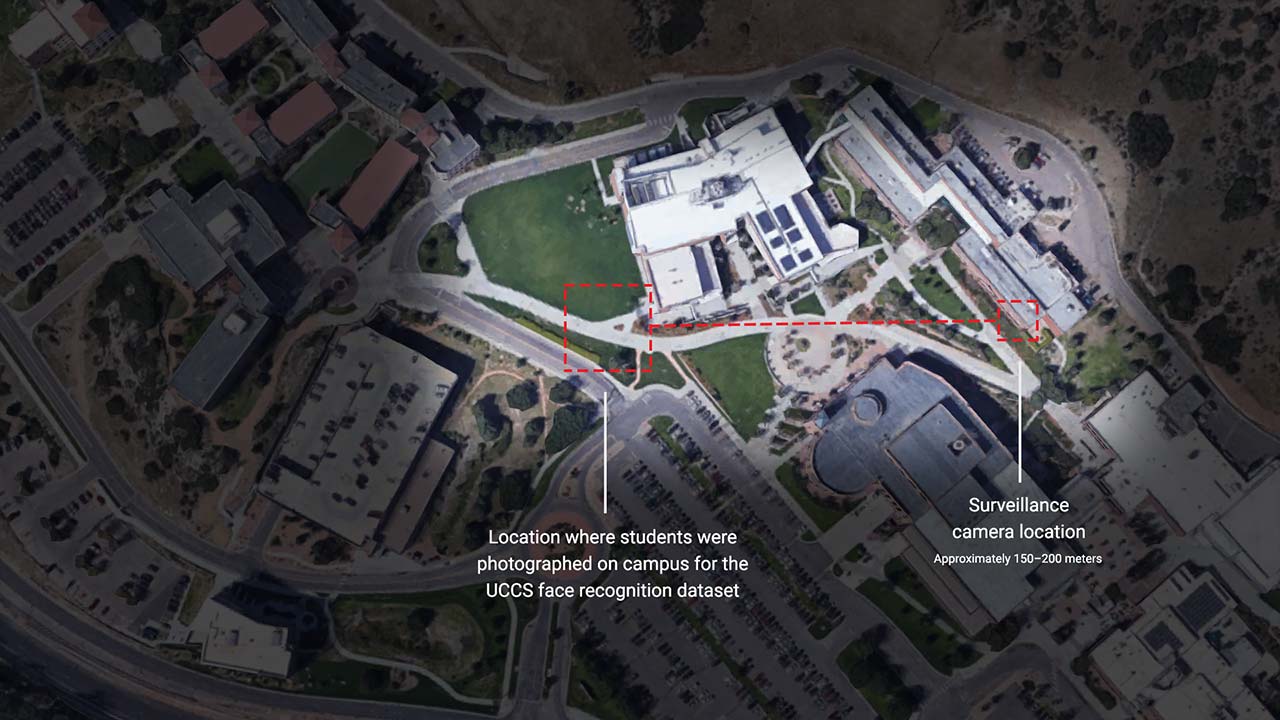
The long-range surveillance images in the UnConsrained College Students dataset were taken using a Canon 7D 18-megapixel digital camera fitted with a Sigma 800mm F5.6 EX APO DG HSM telephoto lens and pointed out an office window across the university's West Lawn. The students were photographed from a distance of approximately 150 meters through an office window. "The camera [was] programmed to start capturing images at specific time intervals between classes to maximize the number of faces being captured." 2 Their setup made it impossible for students to know they were being photographed, providing the researchers with realistic surveillance images to help build face recognition systems for real world applications for defense, intelligence, and commercial partners.
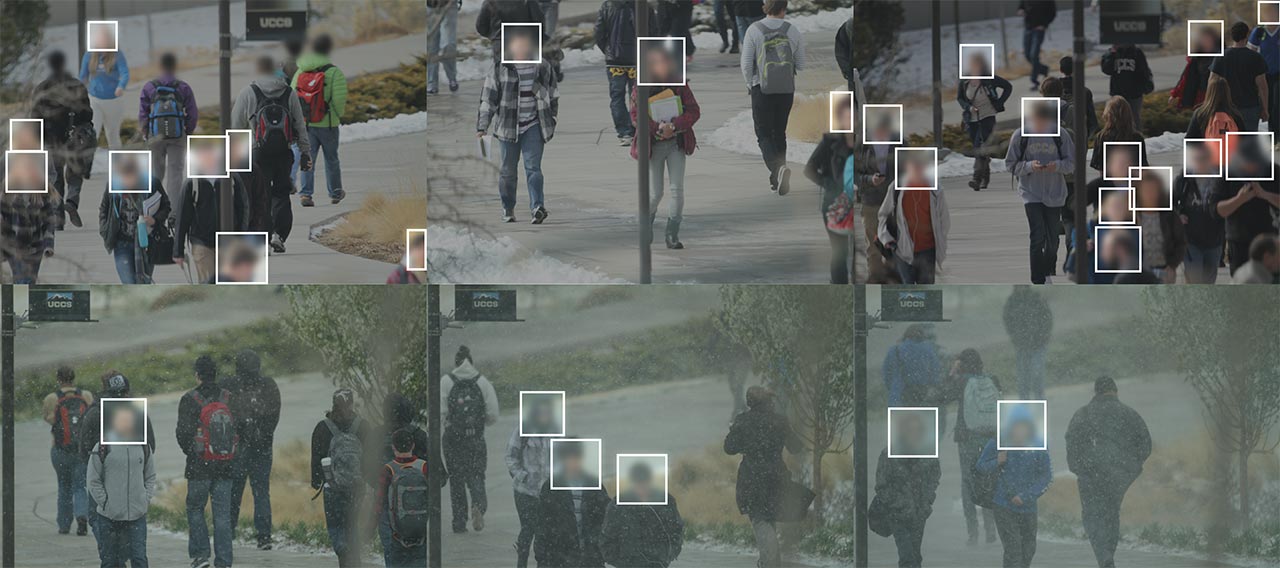
The EXIF data embedded in the images shows that the photo capture times follow a similar pattern to that outlined by the researchers, but also highlights that the vast majority of photos (over 7,000) were taken on Tuesdays around noon during students' lunch break. The lack of any photos taken between Friday through Sunday shows that the researchers were only interested in capturing images of students during the peak campus hours.
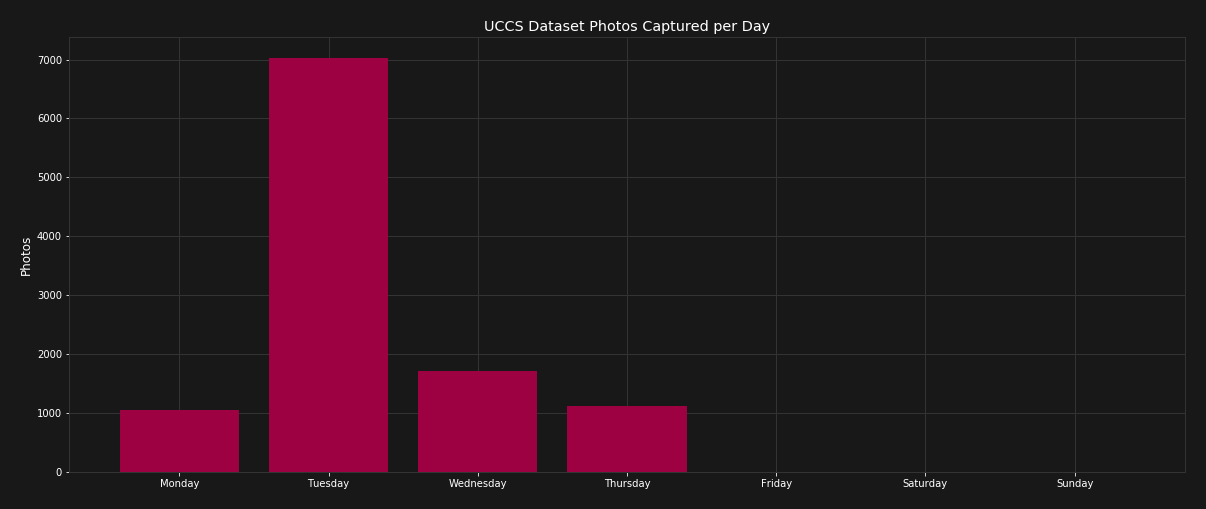
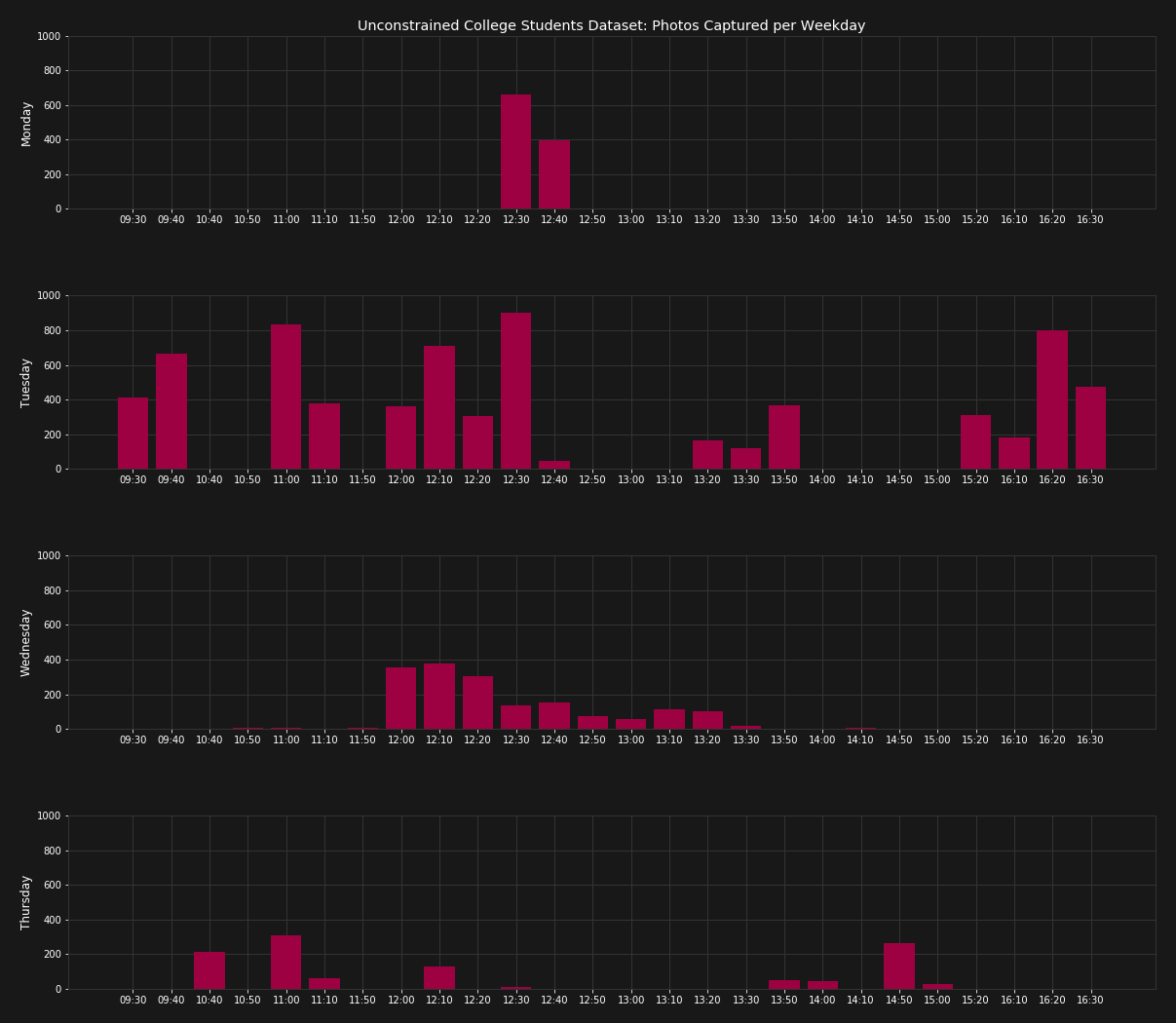
The two research papers associated with the release of the UCCS dataset (Unconstrained Face Detection and Open-Set Face Recognition Challenge and Large Scale Unconstrained Open Set Face Database), acknowledge that the primary funding sources for their work were United States defense and intelligence agencies. Specifically, development of the UnContsrianed College Students dataset was funded by the Intelligence Advanced Research Projects Activity (IARPA), Office of Director of National Intelligence (ODNI), Office of Naval Research and The Department of Defense Multidisciplinary University Research Initiative (ONR MURI), and the Special Operations Command and Small Business Innovation Research (SOCOM SBIR) amongst others. UCCS's VAST site also explicitly states their involvement in the IARPA Janus face recognition project developed to serve the needs of national intelligence, establishing that benefactors of this dataset include United States defense and intelligence agencies, but it would go on to benefit other similar organizations.
In 2017, one year after its public release, the UCCS face dataset formed the basis for a defense and intelligence agency funded face recognition challenge project at the International Joint Biometrics Conference in Denver, CO. And in 2018 the dataset was again used for the 2nd Unconstrained Face Detection and Open Set Recognition Challenge at the European Computer Vision Conference (ECCV) in Munich, Germany.
As of April 15, 2019, the UCCS dataset is no longer available. But during the time it was publicly available (2016 – 2019, based on publicly available resaearch citations) the UCCS dataset appeared in at least 4 research papers including usage from Beihang University who is known to provide research and development for China's military; and Vision Semantics Ltd who lists the UK Ministry of Defence as a project partner.
Updates
June 2, 2019: An email exchange with the author, Professor Terrance Boult, clarified that the he "did not provide data to any government agency when they collected it, nor does it appear that any US Government agency had ever downloaded it as part of the reserach competition." The funding was provided to assess the state of the art technology in face recognition. 5
However, this type of technology is data-driven and advancements are often derived in part from the dataset, as well as the author's own technical contributions.
Information Supply Chain
To help understand how UCCS has been used around the world by commercial, military, and academic organizations; existing publicly available research citing UnConstrained College Students Dataset was collected, verified, and geocoded to show how AI training data has proliferated around the world. Click on the markers to reveal research projects at that location.
- Academic
- Commercial
- Military / Government
Since this site To show the types of face images used in the UCCS student dataset while protecting their individual privacy, a generative adversarial network was used to interpolate between identities in the dataset. The image below shows a generative adversarial network trained on the UCCS face bounding box areas from 16,000 images and over 90,000 face regions.
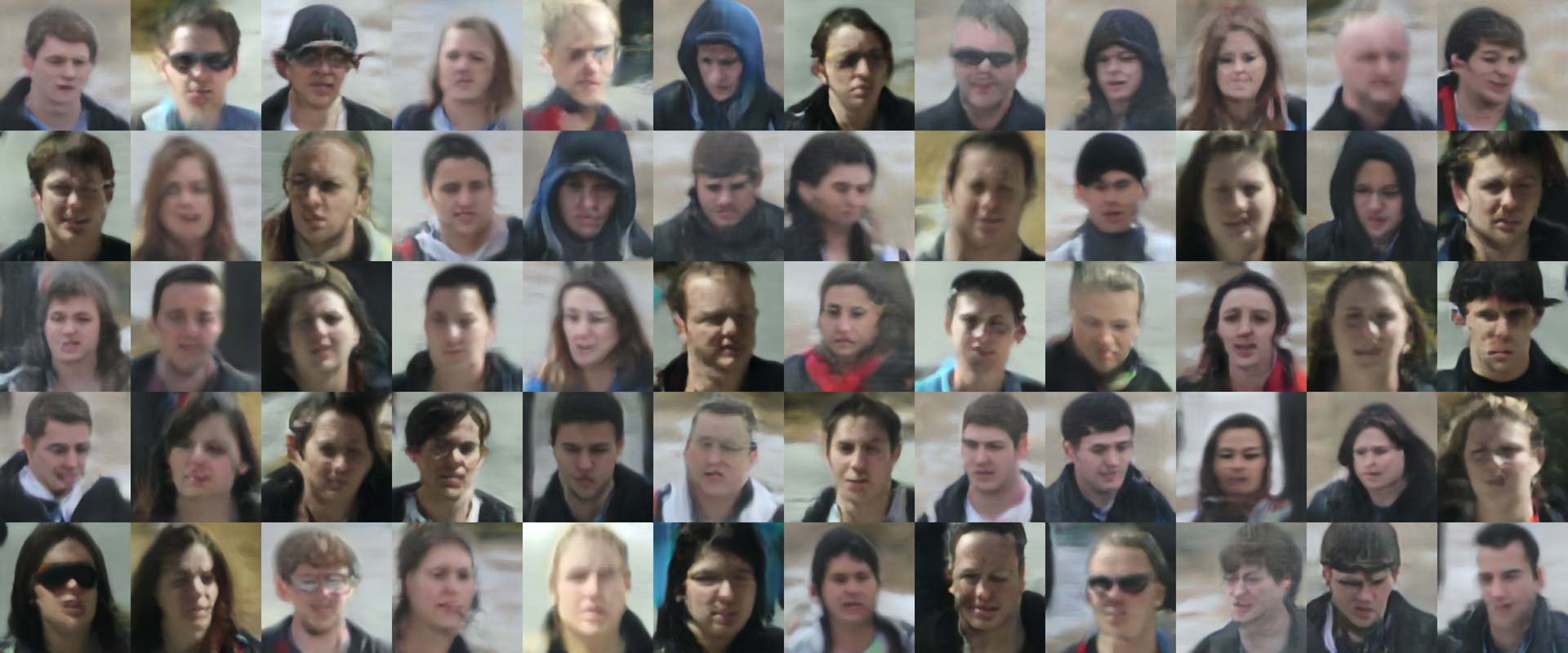
UCCS photos taken in 2012
| Date | Photos |
|---|---|
| Feb 23, 2012 | 132 |
| March 6, 2012 | 288 |
| March 8, 2012 | 506 |
| March 13, 2012 | 160 |
| March 20, 2012 | 1,840 |
| March 22, 2012 | 445 |
| April 3, 2012 | 1,639 |
| April 12, 2012 | 14 |
| April 17, 2012 | 19 |
| April 24, 2012 | 63 |
| April 25, 2012 | 11 |
| April 26, 2012 | 20 |
UCCS photos taken in 2013
| Date | Photos |
|---|---|
| Jan 28, 2013 | 1,056 |
| Jan 29, 2013 | 1,561 |
| Feb 13, 2013 | 739 |
| Feb 19, 2013 | 723 |
| Feb 20, 2013 | 965 |
| Feb 26, 2013 | 736 |
Location
The location of the camera and subjects was confirmed using several visual cues in the dataset images: the unique pattern of the sidewalk that is only used on the UCCS Pedestrian Spine near the West Lawn, the two UCCS sign poles with matching graphics still visible in Google Street View, the no parking sign and directionality of its arrow, the back of street sign next to it, the slight bend in the sidewalk, the presence of cars passing in the background of the image, and the far wall of the parking garage all match images in the dataset. The original papers also provides another clue: a picture of the camera inside the office that was used to create the dataset. The window view in this image provides another match for the brick pattern on the north facade of the Kraember Family Library and the green metal fence along the sidewalk. View the location on Google Maps

Funding
The UnConstrained College Students dataset is associated with two main research papers: "Large Scale Unconstrained Open Set Face Database" and "Unconstrained Face Detection and Open-Set Face Recognition Challenge". Collectively, these papers and the creation of the dataset have received funding from the following organizations:
- ONR (Office of Naval Research) MURI (The Department of Defense Multidisciplinary University Research Initiative) grant N00014-08-1-0638
- Army SBIR (Small Business Innovation Research) grant W15P7T-12-C-A210
- SOCOM (Special Operations Command) SBIR (Small Business Innovation Research) grant H92222-07-P-0020
- National Science Foundation Grant IIS-1320956
- ODNI (Office of Director of National Intelligence)
- IARPA (Intelligence Advance Research Projects Activity) R&D contract 2014-14071600012
Opting Out
If you attended University of Colorado Colorado Springs and were captured by the long range surveillance camera used to create this dataset, there is unfortunately currently no way to be removed. The authors do not provide any options for students to opt-out nor were students informed they would be used for training face recognition. According to the authors, the lack of any consent or knowledge of participation is what provides part of the value of Unconstrained College Students Dataset.
Corrections
- June 11, 2020: Updated to clarify reference from "Surveillance Face Recognition Challenge" 4 that the dataset was the largest "true surveillance" face recognition benchmark dataset. This post referenced an earlier version (V1) of the paper that described it as the largest dataset for "surveillance face recognition". The addition of "true" addresses claims made by the author of the UCCS dataset that this post is inaccurate.
- The dataset author points out that false information was published in media reports erroneously claiming the government collected face data, and notes that government fundeded research does not translate into the government collecting faces.
- The author of the dataset disagrees with an earlier claim made on this site that the UCCS dataset was in the public domain, citing a restrictive license agreement. This post was again referring to a claim made in the "Surveillance Face Recognition Challenge" paper that claimed it was in the public domain. However, only a FOIA could reveal whether it was or was not restrictive. Until then, the site has been amended at the creator's request.
Ethics
- Please direct any questions about the ethics of the dataset to the University of Colorado Colorado Springs Ethics and Compliance Office
- For further technical information about the UnConstrained College Students dataset, visit the UCCS dataset project page.
- Please note that this research was approved by UCCS Institutional Board. The researchers followed protocol and submitted their project for review.
Credits
This analysis contains information from UCCS: UnConstrained College Students dataset, made available under a modified ODC Attribution License http://www.vast.uccs.edu/UCCS/License.txt
Citing This Work
If you reference or use any data from the Exposing.ai project, cite our original research as follows:
@online{Exposing.ai,
author = {Harvey, Adam},
title = {Exposing.ai},
year = 2021,
url = {https://exposing.ai},
urldate = {2021-01-01}
}
If you reference or use any data from UCCS cite the author's work:
@article{Sapkota2013LargeSU,
author = "Sapkota, Archana and Boult, T.",
title = "Large scale unconstrained open set face database",
journal = "2013 IEEE Sixth International Conference on Biometrics: Theory, Applications and Systems (BTAS)",
year = "2013",
pages = "1-8"
}
References
- 1 a"2nd Unconstrained Face Detection and Open Set Recognition Challenge." https://vast.uccs.edu/Opensetface/. Accessed April 15, 2019.
- 2 abArchana Sapkota, et al. "Large scale unconstrained open set face database". 2013 IEEE Sixth International Conference on Biometrics: Theory, Applications and Systems (BTAS). (2013): 1-8.
- 3 aM. Günther, et al. "Unconstrained Face Detection and Open-Set Face Recognition Challenge". 2017 IEEE International Joint Conference on Biometrics (IJCB). (2017): 697-706.
- 4 abZhiyi Cheng, et al. "Surveillance Face Recognition Challenge". ArXiv abs/1804.09691. (2018):
- 5 aEmail exchange on June 2, 2019.